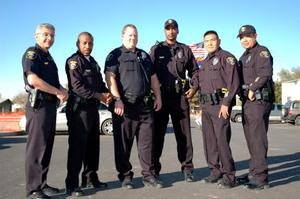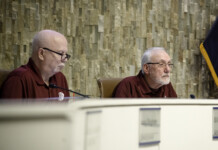
While most of Maricopa was kicking back to celebrate the passing of another year, Police Chief Patrick Melvin and his officers were kicking off the city’s transition from partnering with the Pinal County Sheriff’s Office for public safety services to being the city’s primary, full-time provider.
“It was exciting in the sense that we are now 24/7,” Melvin said of his participation in the young police department’s first-ever night shift which began at 9 p.m. on New Year’s Eve, wrapping up at 7 a.m. Tuesday. “There is a different type of call that happens on the graveyard shift.”
A few noisy, innocuous holiday celebrations aside, the transitional shift appeared to have been uneventful.
“It was a safe night,” Melvin said.
Until the switch, the city of Maricopa had contracted with the PCSO since July to provide police service for all hours outside of the day shift between the hours of 6 a.m. and 4 p.m. when Maricopa Police patrolled the streets. Before then, the PCSO was the sole provider of police services.
These days, Maricopa residents can expect to see two six-officer squads plus a sergeant, lieutenant and the chief on duty during the day shift. One squad will work 10-hour shifts Monday through Thursday and the other will work 10-hour shifts Thursday through Monday.
In addition, five officers will cover the swing shift Monday through Friday with one less on the street on Saturdays and Sundays between the hours of 3 p.m. and 1 a.m.
Another four officers will be on duty during the week during the graveyard shift with three officers with the same shift and responsibilities reporting to work on weekends.
In all, the Police Department includes 42 sworn employees including patrol officers, lieutenants, sergeants, Assistant Chief Kirk Fitch and Chief Melvin.
By June 30, those numbers are expected to climb to 60 or 61.
In contrast, the PSCO during the first six months of when the MPD put officers on the streets, was providing about 20 deputies, Melvin said, although it wasn’t a fixed statistic.
“They had access to more because of being over the entire county, they had the ability to call in more if there was a big issue,” he said.
The growth of the MPD from conception to full capacity has been swift.
It began in September 2006 with the appointment of Melvin, who reported to work Oct. 26, a day after retiring from 21 years of service with the Phoenix Police Department.
His first task was to bring on Fitch as deputy chief of police.
“That is when I started to form the Police Department,” he said. “We had to do everything. We had no building. We had no office. No cars. No uniforms. No badges. We had nothing.”
By February 2007, he’d hired an administrative assistant. Later came two buildings, both donated by the Phoenix Police Department, which are now known as Patrol East and Patrol West.
In mid December, Melvin promoted Fitch from deputy chief of police to the role as an assistant chief.
“The only way we could be where we are today is, No. 1, because the mayor and Council made public safety a priority,” he said. “No. 2, my peer department heads allowed public safety to be at the forefront of priorities,” even when it sometimes meant passing up opportunities for their own departments. “By that, we were able to go on hyper-growth from zero to 24/7 in less than 15 months.”
Officer Stephen Judd, a police spokesman, said they are close to hiring the first six to eight of the 20 or so who will join the department by mid summer.
With so many changes in so little time, Judd said it might take some time to “work out all of the kinks and growing pains, if you will.”
That doesn’t mean things aren’t already going smoothly.
“Maricopa is a very happy place to be right now, as far as the Police Department,” Judd said. “No one is not quite sure of what they are supposed to be doing. We are going 1,000 miles per hour.”
Photo by RuthAnn Hogue



![State: Pinal County fire activity concerning Tucson's Northwest Fire District crew members assist in firefighting efforts on the "Flying Bucket Fire" approximately 15 miles southwest of Maricopa on May 8, 2024. [Northwest Fire District]](https://www.inmaricopa.com/wp-content/uploads/2024/05/GNEq06pbwAA6JlT-218x150.jpg)


![Silk Press Xpress brings Southern hospitality Surrounded by Maricopa Chamber of Commerce Executive Director Kelly Anderson, Councilmember Henry Wade and Board Member Jeremy Waters, LaQuinta Fisher, center, smiles just before a ribbon cutting ceremony at her new salon Silk Press Xpress on April 6, 2024. [Monica D. Spencer]](https://www.inmaricopa.com/wp-content/uploads/2024/05/spencer-040624-silk-press-xpress-ribbon-cutting-web-02-218x150.jpg)
![‘Best moms’ InMaricopa recognized Best Mom's 2024 photo taken at Karsten's Ace Hardware on May 11th, 2024. [Bryan Mordt]](https://www.inmaricopa.com/wp-content/uploads/2024/05/Best-Mom-2024-1-218x150.jpg)



![Carl’s Jr plans to “open soon” An exterior view of the new Carl's Jr. restaurant along John Wayne Parkway on May 7, 2024. [Elias Weiss]](https://www.inmaricopa.com/wp-content/uploads/2024/05/E1C66482-CB4C-4FD0-BA30-35CECE93F4BE-218x150.jpeg)

![Traffic change to reduce backup at Villages intersection The intersection at Butterfield Parkway and West Edison Road on May 10, 2024. [Brian Petersheim Jr.]](https://www.inmaricopa.com/wp-content/uploads/2024/05/PJ_5644-218x150.jpg)


![State: Pinal County fire activity concerning Tucson's Northwest Fire District crew members assist in firefighting efforts on the "Flying Bucket Fire" approximately 15 miles southwest of Maricopa on May 8, 2024. [Northwest Fire District]](https://www.inmaricopa.com/wp-content/uploads/2024/05/GNEq06pbwAA6JlT-100x70.jpg)
